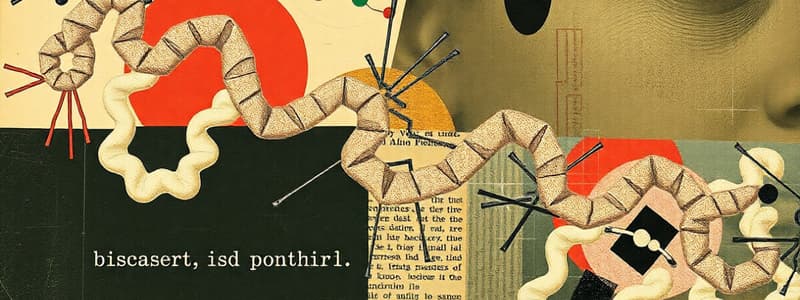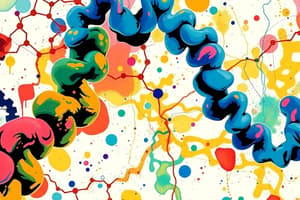Podcast
Questions and Answers
What are the two main types of proteins mentioned in the content?
What are the two main types of proteins mentioned in the content?
- Primary and Secondary
- Fibrous and Folded
- Simple and Complex
- Globular and Fibrous (correct)
Which of the following proteins is responsible for the structure of hair?
Which of the following proteins is responsible for the structure of hair?
- Keratin (correct)
- Myoglobin
- Hemoglobin
- Collagen
The central dogma of protein folding states that the _____ structure determines the ______ structure.
The central dogma of protein folding states that the _____ structure determines the ______ structure.
- Primary, Secondary
- Secondary, Tertiary
- Primary, Tertiary (correct)
- Tertiary, Quaternary
Which of the following is NOT a feature of the fibrous protein Keratin?
Which of the following is NOT a feature of the fibrous protein Keratin?
What is the main structural unit of Collagen?
What is the main structural unit of Collagen?
Which of the following is a characteristic of Globular proteins?
Which of the following is a characteristic of Globular proteins?
Which of the following proteins was the first to have its structure determined using X-ray crystallography?
Which of the following proteins was the first to have its structure determined using X-ray crystallography?
Which of these statements about protein folding is TRUE?
Which of these statements about protein folding is TRUE?
What is the primary role of hemoglobin in the body?
What is the primary role of hemoglobin in the body?
Which of the following accurately describes the structure of myoglobin?
Which of the following accurately describes the structure of myoglobin?
What is the significance of the heme group in myoglobin and hemoglobin?
What is the significance of the heme group in myoglobin and hemoglobin?
What is the difference between the α and β subunits of hemoglobin?
What is the difference between the α and β subunits of hemoglobin?
What is the significance of the T and R structures in hemoglobin?
What is the significance of the T and R structures in hemoglobin?
What causes the change between the T and R structures of hemoglobin?
What causes the change between the T and R structures of hemoglobin?
Which of the following amino acids are found in the interior of the myoglobin molecule?
Which of the following amino acids are found in the interior of the myoglobin molecule?
What is the difference in oxygen carrying capacity between myoglobin and hemoglobin?
What is the difference in oxygen carrying capacity between myoglobin and hemoglobin?
Which of the following amino acids is typically found in the interior of a globular protein?
Which of the following amino acids is typically found in the interior of a globular protein?
Which of the following statements accurately describes the alpha-helix structure?
Which of the following statements accurately describes the alpha-helix structure?
What is the main difference between parallel and anti-parallel beta sheets?
What is the main difference between parallel and anti-parallel beta sheets?
What is the primary role of the quaternary structure in protein function?
What is the primary role of the quaternary structure in protein function?
Which of the following is NOT a characteristic of Concanavalin A?
Which of the following is NOT a characteristic of Concanavalin A?
Which of the following statements is TRUE regarding the amino acid composition of globular proteins?
Which of the following statements is TRUE regarding the amino acid composition of globular proteins?
Which level of protein structure is primarily responsible for the overall shape of a protein?
Which level of protein structure is primarily responsible for the overall shape of a protein?
Which of the following proteins is known to have a high percentage of alpha helices?
Which of the following proteins is known to have a high percentage of alpha helices?
Flashcards
Haemoglobin Structure
Haemoglobin Structure
A tetramer consisting of 2 alpha and 2 beta subunits.
Central Dogma of Protein Folding
Central Dogma of Protein Folding
The primary structure of a protein determines its tertiary structure.
Protein Folding
Protein Folding
The spontaneous process where proteins acquire their functional shape, starting with local secondary structures.
Molecular Chaperones
Molecular Chaperones
Signup and view all the flashcards
Fibrous Proteins
Fibrous Proteins
Signup and view all the flashcards
Keratin Structure
Keratin Structure
Signup and view all the flashcards
Collagen Structure
Collagen Structure
Signup and view all the flashcards
Myoglobin Discovery
Myoglobin Discovery
Signup and view all the flashcards
Alpha Helix
Alpha Helix
Signup and view all the flashcards
Beta Structure
Beta Structure
Signup and view all the flashcards
Super Secondary Structures
Super Secondary Structures
Signup and view all the flashcards
Globular Protein
Globular Protein
Signup and view all the flashcards
Quaternary Structure
Quaternary Structure
Signup and view all the flashcards
Oligomeric Proteins
Oligomeric Proteins
Signup and view all the flashcards
Dimer
Dimer
Signup and view all the flashcards
Domains in Proteins
Domains in Proteins
Signup and view all the flashcards
Myoglobin
Myoglobin
Signup and view all the flashcards
Haem group
Haem group
Signup and view all the flashcards
Alpha helices in Myoglobin
Alpha helices in Myoglobin
Signup and view all the flashcards
Tense (T) vs Relaxed (R) structure
Tense (T) vs Relaxed (R) structure
Signup and view all the flashcards
Oxygen binding in Hemoglobin
Oxygen binding in Hemoglobin
Signup and view all the flashcards
Iron in Haem
Iron in Haem
Signup and view all the flashcards
Proline's role
Proline's role
Signup and view all the flashcards
Study Notes
Protein Structure Summary
- Proteins are complex molecules crucial for various bodily functions
- Amino acids are the building blocks of proteins
- Protein structure is hierarchical, progressing from primary to quaternary
- Primary structure: The linear sequence of amino acids
- Secondary structure: Localized folding patterns (e.g., alpha-helices, beta-sheets) stabilized by hydrogen bonds. Alpha-helices are right-handed and form a coiled structure; beta-sheets are formed by hydrogen bonding between side chains and typically have a pleated appearance
- Tertiary structure: The overall 3D shape of a polypeptide chain, stabilised by interactions between R-groups of amino acids (including the hydrophobic effect, hydrogen bonds, and ionic bonds, disulfide bonds).
- Quaternary structure: The arrangement of multiple polypeptide chains in a protein with more than one chain.
- Fibrous proteins have elongated structures (e.g., keratin, collagen), while globular proteins have compact, spherical shapes (e.g., myoglobin, hemoglobin).
- Fibrous proteins have high tensile strength and are often structural components, like tendons, cartilage, hair or silk fibres
- Globular proteins often carry out functions like transport, catalysis (enzymes), and signaling (hormones)
- Myoglobin and hemoglobin are examples of globular proteins involved in carrying oxygen
- Protein folding and stability are dependent on various interactions between amino acid side chains
- Denaturation occurs when a protein loses its native structure, often due to changes in temperature, pH, or salt concentration; loss of function follows loss of shape
Myoglobin Structure
- Myoglobin is a small protein with 153 amino acid residues; it is a common example of a globular protein.
- It is found in muscle tissue
- Its main role is to store oxygen
- The molecule is extremely compact
- A significant portion, about 75%, of the polypeptide consists of alpha helices
Hemoglobin Structure
- Hemoglobin serves as the oxygen-transport protein in red blood cells; it's a large, globular protein, consisting of 4 polypeptide chains.
- Each chain is very similar to myoglobin, but it carries 4 polypeptide chains instead of just one; 2 alpha and 2 beta chains
- Contains a prosthetic group called heme, which includes an iron atom
- The heme group is crucial for oxygen binding
- Hemoglobin has two main conformations: T state (low oxygen affinity) and R state (high oxygen affinity).
- Small changes in the structure of the protein influence the affinity of oxygen
Characteristics of A-Keratin
- Keratin is predominantly a fibrous protein
- A-keratin is rich in hydrophobic amino acids, making it insoluble in water
- A-keratin lacks proline, which prevents helix breaking
- Disulfide bonds contribute to the stabilization of keratin structure
- Disulfide bonds can be broken (e.g. by reducing agents) and reformed (by oxidizing agents), leading to changes in the structure and function of the hair
- This process is used to generate permanent hairstyles
Collagen Structure
- Collagen is a highly abundant fibrous protein
- Its basic unit is a collagen polypeptide that forms a left-handed helix
- Collagen molecules assemble into a triple helix structure
- The triple helix is stabilized by hydrogen bonds, and the protein is rich in glycine, proline, and hydroxyproline residues.
- Proline and hydroxyproline residues are key to the formation of the triple helix structure
- The structure of collagen is critical in forming strong structural tissues (e.g., tendons, skin, cartilage)
Studying That Suits You
Use AI to generate personalized quizzes and flashcards to suit your learning preferences.



